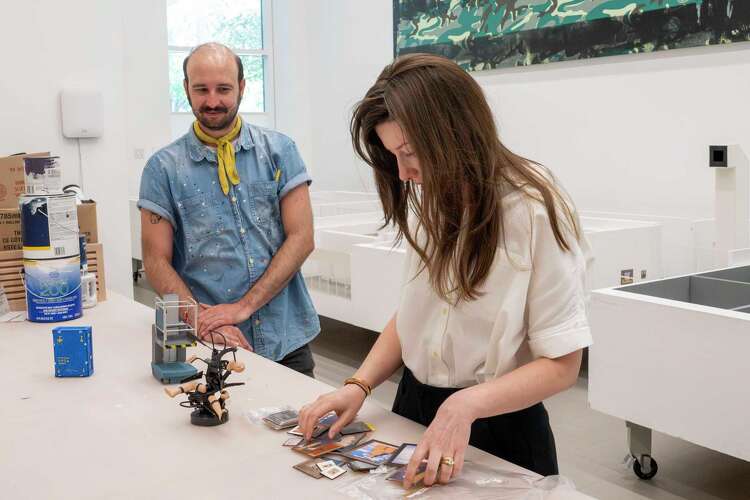Inside the Menil Collection's Model Room: Curators Play with Galleries Like Dollhouses

The Hidden Gem of the Menil Collection
If you find yourself entering the Menil Collection's main building from the Branard Street side, you'll first encounter a plain white wall on your left. To proceed further, you'll need to pass by a security guard stationed behind an imposing desk. Access to the inner areas requires either an employee badge or an escorted visit. Trust us, it's well worth the effort.
Tucked away in a long, windowless room, you'll discover what the museum staff refer to as "the model room." For those unfamiliar with the art world, this space might be described more simply as "gallery dollhouses." These are miniature replicas of the museum itself, designed to be exact scale models of the galleries. Every detail, from the furniture and artwork to the model people—both real and imagined—is meticulously recreated.
The model room is a unique space where every piece of art that has ever been displayed at the Menil, whether on loan or part of the permanent collection, has been replicated. This includes the Menil Drawing Institute, which also has its own model room in its respective building on W. Main Street. The concept was envisioned by Dominique and John de Menil, who believed in the importance of such a space. An archival image even shows Dominique playing with a model room wall back in 1973.
"The model room was always intended to be a space for curators to experiment," explains Natalie Dupêcher, associate curator of modern art. "It's like a dollhouse where we can play with gallery layouts and create exhibitions in a fun, interactive way."
The Art of Miniature Reproduction
One of the key figures in this process is Kent Dorn, whose role is taken very seriously. To accurately recreate sculptor Robert Gober's "Untitled" (2005), a block of Gruyère cheese with a full head of hair, Dorn used strands from his own sandy hair. The original cheese, made with beeswax, was on display at the Menil in 2022. Dorn’s model now resides in a glass bookcase next to miniature Alexander Calder sculptures.
Vincent Krough, the Menil's official model-maker, often goes above and beyond. When unpacking a framed painting of Cornelis de Heem's "A Swag of Fruit and Flowers Hanging in a Casement," he uses a palm-sized wooden crate painted in "Menil blue," a color reminiscent of Yves Klein's International Klein Blue. Krough enjoys experimenting with new materials and techniques, often turning discarded items into treasures for the model room.
The Process Behind the Models
Curators begin planning for an exhibition months in advance, compiling a wish list of artworks they want to include. Once confirmed, Krough and his team start working on the models. Ideally, these models are completed one and a half years before the exhibition opens, taking about two weeks to finish. A painting, referred to by Dupêcher as "chips," usually takes a day to complete, while three-dimensional objects and their platforms require more time.
Krough's model of Jean Tinguely's "Dissecting Machine" (1965) looks like something out of a horror film, but when viewed in person, it closely resembles the original. "It actually does look like that," he says proudly, holding a prop. "And it moves!"
In the far west gallery known as the "West80," the models are so accurate that they give a clear idea of how the exhibition will look. While the staff is generally relaxed, there are strict rules: only the curator of a given show is allowed to move anything around. Touching the models is strictly prohibited.
Planning and Finalizing the Exhibition
Dorn and his team then take over the next phase, which involves digital renderings. "It's a more elaborate process," he explains. "In the model room, you can just grab art and place it, but with digital renderings, I get to figure out what the real stars are when I see it to scale."
Dorn also manages the model room archives, which have evolved from hand-drawn sketches and Xeroxes to digital prints. He shows off a Ziploc bag filled with postage stamp-sized Surrealist paintings by René Magritte to illustrate the difference.
Some artists who have exhibited at the Menil have contributed to the model room, while others, like Tacita Dean, have taken miniatures of their work as souvenirs after their shows closed. "She was totally enchanted by the model room," Dorn recalls.
The model room is not just a replica—it's a vital tool for curators, helping them make spatial decisions and visualize the final exhibition. It's a testament to the creativity and dedication of the Menil staff, ensuring that every detail is perfectly captured.
Post a Comment for "Inside the Menil Collection's Model Room: Curators Play with Galleries Like Dollhouses"
Post a Comment